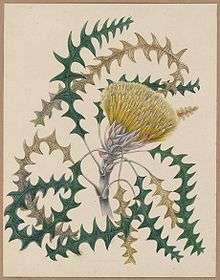Banksia dallanneyi
Banksia dallanneyi, commonly known as couch honeypot,[2] is a species of prostrate shrub that is endemic to Western Australia. It only has a short above-ground stem, pinnatipartite or pinnatisect leaves, between thirty and seventy variously coloured flowers and glabrous, egg-shaped fruit.
| Couch honeypot | |
|---|---|
| Banksia dallanneyi at Cottonwood Crescent Reserve, Dianella | |
| Scientific classification | |
| Kingdom: | Plantae |
| Clade: | Tracheophytes |
| Clade: | Angiosperms |
| Clade: | Eudicots |
| Order: | Proteales |
| Family: | Proteaceae |
| Genus: | Banksia |
| Subgenus: | Banksia subg. Banksia |
| Series: | Banksia ser. Dryandra |
| Species: | B. dallanneyi |
| Binomial name | |
| Banksia dallanneyi | |
| Synonyms[1] | |

Description
Banksia dallanneyi is a shrub that sometimes grows to a height of 3 m (9.8 ft) and has a fire-tolerant, underground stem and only a short above-ground stem. It has pinnatipartite or pinnatisect leaves that are 60–200 mm (2.4–7.9 in) long and 2–20 mm (0.079–0.787 in) wide on a petiole 10–120 mm (0.39–4.72 in) long. There are between ten and eighty triangular to oblong lobes on each side of the leaves and the lower surface is covered with woolly white hairs. The flowers are arranged in heads of between thirty and seventy with linear to lance-shaped involucral bracts 15–25 mm (0.59–0.98 in) long at the base of the head. The flowers have a cream-coloured, golden yellow or pinkish perianth 20–35 mm (0.79–1.38 in) long and a cream-coloured, pink or maroon pistil 30–40 mm (1.2–1.6 in) long. Flowering occurs from May to October and the fruit is an egg-shaped, mostly glabrous follicle 7–13 mm (0.28–0.51 in) long.[2][3][4]
Taxonomy and naming
Couch honeypot was first formally described in 1845 by Carl Meissner who gave it the name Dryandra lindleyana and published the description in Lehmann's Plantae Preissianae.[5][6]
In 1996, Alex George described five subspecies, one subspecies with two varieties:[4]
- Dryandra lindleyana subsp. sylvestris with oblong or linear leaf lobes;
- Dryandra lindleyana subsp. lindleyana with triangular leaf lobes, the leaves divided to, or almost to the mid-vein and 3–10 mm (0.12–0.39 in) wide with thirty to sixty lobes on each side;
- Dryandra lindleyana var. lindleyana as for subsp. lindleyana but with the above-ground stem less than 10 cm (3.9 in) long;
- Dryandra lindleyana var. mellicula as for subsp. lindleyana but with the above-ground stem more than 45 cm (18 in) tall;
- Dryandra lindleyana subsp. pollosta with triangular leaf lobes, the leaves divided to, or almost to the mid-vein and 2–3 mm (0.079–0.118 in) wide with sixty to eighty lobes on each side;
- Dryandra lindleyana subsp. media with asymmetrical leaf lobes, the lower margin shallowly S-shaped or dished;
- Dryandra lindleyana subsp. agricola with triangular leaf lobes, the leaves divided 1⁄2 to 3⁄4 to the mid-vein.
In 2007, Austin Mast and Kevin Thiele transferred all Dryandra species to Banksia. As there was already a species named Banksia lindleyana (porcupine banksia), Mast and Thiele changed the specific epithet to "dallanneyi", an anagram of "lindleyana".[7][8][9]
The changed names of the subspecies and varieties are as follows and are accepted at the Australian Plant Census:
Distribution and habitat
Banksia dallanneyi grows on flats and rises in a range of soil types between Geraldton and Albany.[2][3]
Ecology
An assessment of the potential impact of climate change on this species found that its range is likely to contract by between 30% and 80% by 2080, depending on the severity of the change.[17]
| Wikimedia Commons has media related to Banksia dallanneyi. |
References
- "Banksia dallanneyi". Australian Plant Census. Retrieved 21 April 2020.
- "Banksia dallanneyi". FloraBase. Western Australian Government Department of Parks and Wildlife.
- George, Alex S. (1999). Flora of Australia (PDF). 17B. Canberra: Australian Biological Resources Study, Canberra. pp. 353–357. Retrieved 21 April 2020.
- George, Alex (1996). "New taxa and a new infrageneric classification in Dryandra R.Br. (Proteaceae:Grevilleoideae)". Nuytsia. 10 (3): 393–398. Retrieved 21 April 2020.
- "Dryandra lindleyana". APNI. Retrieved 21 April 2020.
- Meissner, Carl; Lehmann, Johann G.C. (ed.) (1845). Plantae Preissianae. Hamburg: Sumptibus Meissneri. pp. 598–599. Retrieved 21 April 2020.CS1 maint: extra text: authors list (link)
- "Banksia dallanneyi". APNI. Retrieved 21 April 2020.
- Mast, Austin R.; Thiele, Kevin (2013). "The transfer of Dryandra R.Br. to Banksia L.f. (Proteaceae)". Australian Systematic Botany. 20 (1): 63–71. doi:10.1071/SB06016.
- Francis Aubie Sharr (2019). Western Australian Plant Names and their Meanings. Kardinya, Western Australia: Four Gables Press. p. 178. ISBN 9780958034180.
- "Banksia dallanneyi subsp. agricola". Australian Plant Census. Retrieved 21 April 2020.
- "Banksia dallanneyi subsp. dallanneyi". Australian Plant Census. Retrieved 21 April 2020.
- "Banksia dallanneyi var. dallanneyi". Australian Plant Census. Retrieved 21 April 2020.
- "Banksia dallanneyi var. mellicula". Australian Plant Census. Retrieved 21 April 2020.
- "Banksia dallanneyi subsp. media". Australian Plant Census. Retrieved 21 April 2020.
- "Banksia dallanneyi subsp. pollosta". Australian Plant Census. Retrieved 21 April 2020.
- "Banksia dallanneyi subsp. sylvestris". Australian Plant Census. Retrieved 21 April 2020.
- Fitzpatrick, Matthew C.; Gove, Aaron D.; Sanders, Nathan J.; Dunn, Robert R. (2008). "Climate change, plant migration, and range collapse in a global biodiversity hotspot: the Banksia (Proteaceae) of Western Australia". Global Change Biology. 14 (6): 1–16. doi:10.1111/j.1365-2486.2008.01559.x.
- Cavanagh, Tony; Pieroni, Margaret (2006). The Dryandras. Melbourne: Australian Plants Society (SGAP Victoria); Perth: Wildflower Society of Western Australia. ISBN 1-876473-54-1. OCLC 149312882.